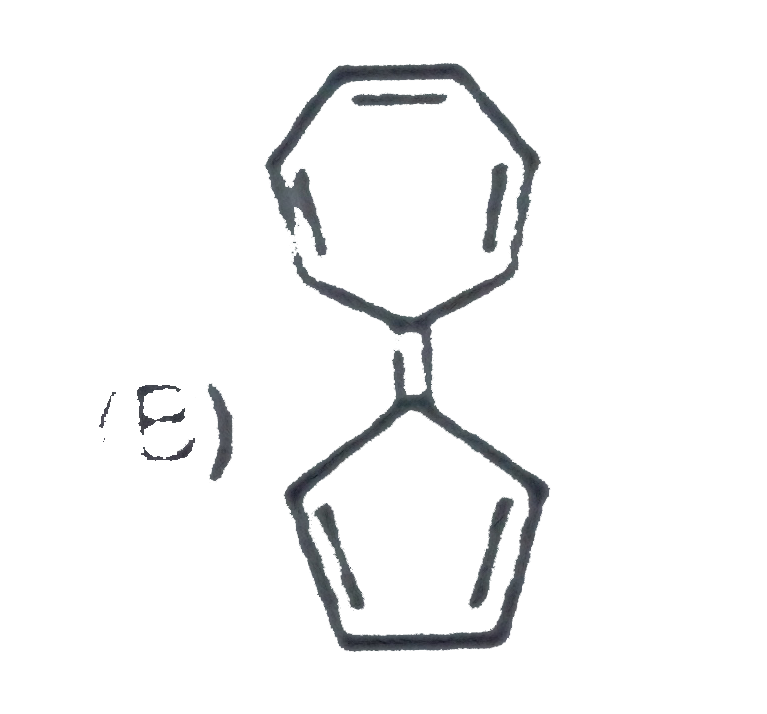C12H10 is an aromatic compound which on ozonolysis gives mixture of Glyoxal and 2-Oxopropanedial in ratio 3:2 it structure can be :




The correct Answer is:B
To solve the problem, we need to identify the structure of the aromatic compound C12H10 that, upon ozonolysis, yields a mixture of glyoxal and 2-oxopropanedial in a ratio of 3:2.
Step 1: Understand the Products
The products of ozonolysis mentioned are:
- Glyoxal (CHOCHO)
- 2-Oxopropanedial (CHOCH2CHO)
Step 2: Determine the Structure of the Compound
Given that the ratio of glyoxal to 2-oxopropanedial is 3:2, we can infer that the starting compound must have multiple double bonds that can be cleaved by ozonolysis.
Step 3: Consider Possible Structures
Since the compound is aromatic and has a molecular formula of C12H10, we can consider structures that have multiple double bonds. One likely candidate is a compound with two substituents on a benzene ring that can lead to the formation of the two products.
Step 4: Analyze the Ozonolysis Reaction
During ozonolysis, the double bonds in the aromatic compound will break, and ozonolysis will introduce oxygen atoms, forming the aldehyde products.
Step 5: Construct the Structure
After analyzing various structures, we find that the compound that fits the criteria is 1,2-diphenylethylene. The ozonolysis of this compound would yield:
- 3 molecules of glyoxal
- 2 molecules of 2-oxopropanedial
Conclusion
Thus, the structure of the aromatic compound C12H10 that gives the specified products in the required ratio is 1,2-diphenylethylene.
The products of ozonolysis mentioned are:
- Glyoxal (CHOCHO)
- 2-Oxopropanedial (CHOCH2CHO)
Given that the ratio of glyoxal to 2-oxopropanedial is 3:2, we can infer that the starting compound must have multiple double bonds that can be cleaved by ozonolysis.
Since the compound is aromatic and has a molecular formula of C12H10, we can consider structures that have multiple double bonds. One likely candidate is a compound with two substituents on a benzene ring that can lead to the formation of the two products.
During ozonolysis, the double bonds in the aromatic compound will break, and ozonolysis will introduce oxygen atoms, forming the aldehyde products.
After analyzing various structures, we find that the compound that fits the criteria is 1,2-diphenylethylene. The ozonolysis of this compound would yield:
- 3 molecules of glyoxal
- 2 molecules of 2-oxopropanedial
Thus, the structure of the aromatic compound C12H10 that gives the specified products in the required ratio is 1,2-diphenylethylene.
Topper's Solved these Questions
Similar Questions
An alkene ‘A’ on ozonolysis gives a mixture of ethanal and pentan-3-one. Write structure and IUPAC name of ‘A’.
View SolutionAn organic compound E(C5H8) on hydrogenation gives compoundF(C5H12). Compound E on ozonolysis gives formaldehyde and 2-ketopropanal. Deduce the structure of compound E.
View Solution
Knowledge Check
An organic compound C4H6 on ozonolysis give HCHO,CO2,CH3CHO. Compound will be:
AH2C=CH−CH=CH2BCH3−CH=C=CH2CCH3−C=C−CH3D
An organic compound (A) C5H10O2 reacts with Br2 in presence of phosphorus to give (B). Compound (B) contains an asymmetric carbon atom and yields (C) on dehydrobromination. Compound (C) does not show geometrical isomerism and on decarboxylation gives an alkene (D) which on ozonolysis gives E and F. Compound (E) gives positive Schiff test but (F) does not.
Find out structure of D:A B
B C
C D
D
Which of the following compounds gives a mixture of SO2 and SO3
on heating ?
View SolutionAn organic compound with molecular formula C6H12 upon ozonolysis gives only acetone as the product. The compound is :
View SolutionCompound A C6H12 forms two monochloro isomers on photochemical chlorination. Its structure can be :
View SolutionAn organic compound X(C5H10) on ozonolysis gives Y & Z. The product mixture Y and Z on reaction with NH2−OH gives four oximes.The structure of X is
View SolutionAn unknown compound on ozonolysis to give acid C3H6O2 and a ketone C4H8O. From this information identify structure of unknown compound.
View SolutionCompound A(C6H12) does not absorb H2 in presence of Ni. It forms two monochloro isomers on photochemical chlorination . Its structure can be
View Solution
